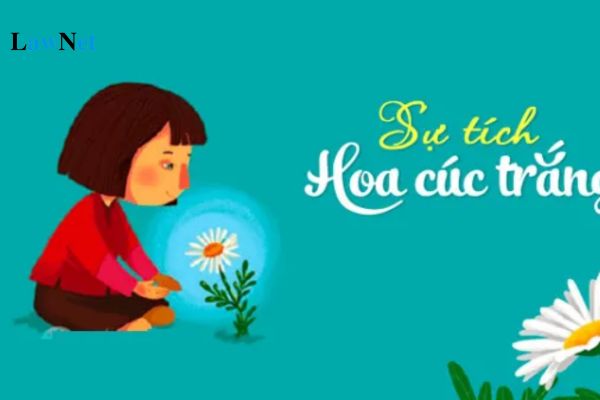What are the 02+ sample retellings of the fairy tale "Sự tích hoa cúc trắng"? Who approves the 1st-grade Vietnamese language textbooks?
What are the 02+ sample retellings of the fairy tale "Sự tích hoa cúc trắng"?
"Sự tích hoa cúc trắng" is a fairy tale about a young girl's filial piety towards her mother. The story narrates how a girl, whose mother was gravely ill, went up a mountain to find a four-petal white chrysanthemum to save her mother. Through many hardships, she found the flower, but it only had four petals. At that moment, the flower emitted a miraculous light and transformed into a multi-petal white chrysanthemum. Her mother recovered thanks to it.
Retelling the fairy tale "Sự tích hoa cúc trắng" is practiced in the 1st-grade Vietnamese language curriculum.
1st-grade students can refer to the following sample retellings of the fairy tale "Sự tích hoa cúc trắng":
|
Sample retellings of the fairy tale "Sự tích hoa cúc trắng" Once upon a time, there were a mother and daughter living in a small, simple hut. The mother was kind and diligent, working hard to raise her child. The daughter was very obedient and filial, always hoping her mother would have a happy life.
Long ago, in a small village, there lived a mother and daughter who relied on each other. The mother was severely ill, but the family was poor and couldn't afford treatment. The daughter loved her mother deeply, searching day and night for ways to relieve her mother's pain. |
*Note: The information is for reference only./.

What are the 02+ sample retellings of the fairy tale "Sự tích hoa cúc trắng"? Who approves the 1st-grade Vietnamese language textbooks? (Image from the Internet)
Who approves the 1st-grade Vietnamese language textbooks?
According to Article 18 of the Primary School Regulations attached to Circular 28/2020/TT-BGDDT, the use of textbooks in primary schools in Vietnam is stipulated as follows:
Textbooks, Teaching Equipment, Reference Materials, and Local Educational Materials
1. Primary school utilizes textbooks approved by the Minister of Education and Training and the choice and use are decided by the provincial People's Committee for teaching and learning activities in local primary schools; teachers and students use textbooks in teaching and learning activities to achieve the educational goals, content, and student competence requirements specified in the primary education program; primary schools must promptly provide full information about the textbooks used at the school for students and their families to know.
...
Thus, the 1st-grade Vietnamese language textbooks are approved by the Minister of Education and Training.
What is the process of selecting 1st-grade Vietnamese language textbooks at primary schools in Vietnam?
In Article 7 of Circular 27/2023/TT-BGDDT, the process of selecting 1st-grade Vietnamese language textbooks at primary schools in Vietnam is specified as follows:
- Step 1: The council develops a plan for organizing the selection of textbooks for the primary school; and assigns duties to the council members.
- Step 2: Organizing the selection of textbooks within the professional team
+ Based on the council's plan and selection criteria for textbooks, the head of the professional team creates a plan to organize the selection of textbooks for each subject structured within the team, reporting to the head before implementation;
+ Organizing for all teachers of the subject at the primary school (including official, contract, deputed, visiting, and multi-school teachers) to participate in the selection of textbooks for that subject;
+ No later than 20 days before the 1st session of the professional team, the head of the professional team organizes teachers to research subject textbooks, write comments, and evaluate textbooks based on selection criteria;
+ The head of the professional team holds meetings with subject teachers to discuss and vote for selecting one (1) textbook for that subject.
If a subject has only one textbook approved by the Minister of Education and Training, the professional team selects the textbook as decided, without voting.
The chosen textbooks must have at least 1/2 (one-half) of the teachers of the subject voting in favor.
If no textbook receives at least 1/2 (one-half) of the votes from teachers, the professional team must discuss and vote again; the selected textbook is the one with the highest number of votes in the second round.
In both rounds of voting, if there are two textbooks with the highest equal votes, the head of the professional team decides on one of them.
The meetings of the professional team must be recorded, documenting all comments evaluating the textbooks, signed by the head and the person assigned to record;
+ The head of the professional team compiles results and lists the textbooks selected by the team, signed by both the head and the person tasked with the listing.
- Step 3: The council meets to discuss and evaluate the organization of textbook selection by the professional teams; verifies meeting records from the professional teams; reviews teacher feedback, and evaluates textbooks as stipulated in Clause 2, Article 7 of Circular 27/2023/TT-BGDDT; compiles the selection results from the professional teams into a report (including comments on the textbook selection organization and lists of selected textbooks), signed by the Chairman and Secretary of the council.
- Step 4: The council proposes to the head the list of textbooks selected as per Circular 27/2023/TT-BGDDT.
- Step 5: The primary school compiles the textbook selection dossier and sends it to the Division of Education and Training (for primary and lower secondary levels) and the Department of Education and Training (for upper secondary level).

